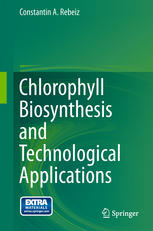

Most ebook files are in PDF format, so you can easily read them using various software such as Foxit Reader or directly on the Google Chrome browser.
Some ebook files are released by publishers in other formats such as .awz, .mobi, .epub, .fb2, etc. You may need to install specific software to read these formats on mobile/PC, such as Calibre.
Please read the tutorial at this link: https://ebookbell.com/faq
We offer FREE conversion to the popular formats you request; however, this may take some time. Therefore, right after payment, please email us, and we will try to provide the service as quickly as possible.
For some exceptional file formats or broken links (if any), please refrain from opening any disputes. Instead, email us first, and we will try to assist within a maximum of 6 hours.
EbookBell Team

4.4
82 reviewsHeme and chlorophyll (Chl) are porphyrins. Porphyrins (also referred to as tetrapyrroles) are essential for life in the biosphere. Chlorophyll catalyzes the conversion of solar energy to chemical energy via the process of photosynthesis. Organic life in the biosphere is made possible by consumption of the chemical energy generated by photosynthesis. Hemes are the prosthetic groups of cytochromes which are involved in electron transport during oxidative phosphorylation and photosynthetic phosphorylation which generate ATP and NADPH. The latter are essential for many cellular functions. Chlorophyll on the other hands catalyzes the process of photosynthesis. Indeed, life in the biosphere depends on the process of photosynthesis which converts light energy, carbon dioxide and water into the chemical energy, required for the formation of food and fiber. Photosynthetic efficiency is controlled by extrinsic factors such as the availability of water, CO2, inorganic nutrients, ambient temperature and the metabolic and developmental state of the plant, as well as by intrinsic factors (Lien and San Pietro, 1975). The most important intrinsic factor is the efficiency of the photosynthetic electron transport system (PETS). Conventional agriculture is one of the few human activities that have not undergone a revolution to join other activities such as overcoming gravity by flying, and landing on the moon, crossing underwater the polar cap, and communicating wirelessly over long distances via electromagnetic waves. We now feel that enough biochemical and molecular biological knowledge has accumulated to render this dream amenable to experimentation. We believe that the time has come to bioengineer chloroplasts capable of synthesizing a short chain carbohydrate such as glycerol at rates that approach the upper theoretical limits of photosynthesis [Rebeiz, C. A. (2010) Investigations of possible relationships between the chlorophyll biosynthetic pathway and the assembly of chlorophyll-protein complexes and photosynthetic efficiency. In: Rebeiz, C. A. Benning, C., Bohnert, H.J., Daniell, H., Hoober J. K., Lichtenthaler, H. K., Portis , A. R., and Tripathy, B. C. eds. The chloroplast: Basics and Applications. Springer. The Netherlands, p 1-24]. In order to achieve this goal a thorough knowledge of the Chl biosynthetic pathway is needed along with knowledge in other domains (Rebeiz 2010). In this context, this monograph is devoted to an in depth discussion of our present knowledge of the Chl biosynthetic pathway. The complexity and biochemical heterogeneity of the Chl biosynthetic pathway and the relationship of this complexity to the structural and biosynthetic complexity of photosynthetic membranes will be emphasized. We will also emphasize in historical perspective, key stages in our understanding of the Chl biosynthetic heterogeneity. The reader should keep in mind that a complex biosynthetic process is only fully understood when it becomes possible to reconstitute in vitro every step of the process. We are not yet at this stage of understanding of thylakoid membrane biogenesis. Considerable progress has been achieved however, in the understanding of numerous facets of the Chl biosynthetic pathway, namely (a) detection and identification of various major and minor metabolic intermediates (b) precursor-product relationships between various intermediates, (c) structure and regulation of many enzymes of the pathway, and (d) the relationship of the Chl biosynthetic heterogeneity to the structural and functional heterogeneity of thylakoid membranes. In addition topics related to the development of Analytical techniques, Cell-free systems, Herbicides, Insecticides, and Cancericides are also discussed.